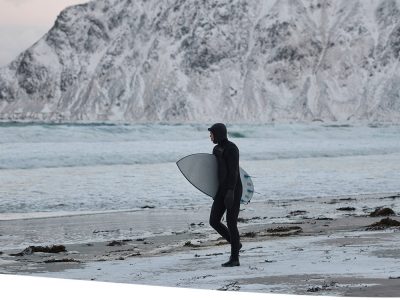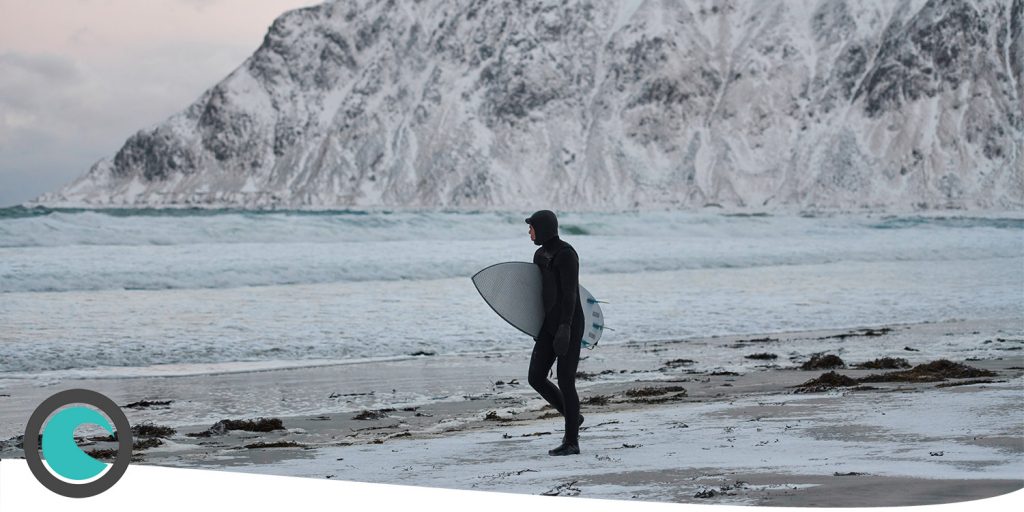The question we get asked a lot in the shop is along the lines of why is this 5mm wetsuit £150 and this one £400. Once you get past the obvious visible differences like back zip and chest zip, the differences aren’t easy to see. This can be broken down even further to why is this back zipped suit £150 and this other one £250. The same applies to chest zipped suits, so we’ll try explain the differences for you here.
First the choice:
- Back Zip or Chest Zip:
- Not all Back Zip wetsuits are the same, yes there are material differences as I will discuss below, but there are also 2 different styles of back zip, ones with just a zip and ones with the same zip but also an overhead back flush panel. The latter includes a thin piece of lined neoprene, with a hole at the top through which to put your head, that is stitched inside the back of the suit. Once you have your arms and legs in the suit, before you do it up, you pull this thin layer up and put it over your head, then do the zip up. The reason for this is because most water ingress (flushing) in a backzip suit comes through the seal around your neck where the zip doesn’t allow a perfect seal. This back panel means that any water that gets in at this point, instead of running straight down your back in to your suit, gets trapped by this panel and directed back out of the suit by a few little holes at the bottom of the zip!
- Chest zips eliminate flushing almost completely as the seal around your neck is almost perfect without the need for a zip in that location. The con to this though is that they are more difficult to get into and out of. There is a technique to getting them on and off, but a person trying for the first time in a shop might not immediately see the benefits of it and give up. In our opinion they are definitely worth learning to get in and out of them as the benefits once you are in the water can be seen as soon as you have to dive through your first wave.
Here is the detail on why one suit is £150 and another similar style suit £300 or £400:
- Material Quality:
- Inexpensive wetsuits often use lower-grade, low stretch, neoprene or a lower percentage of high-quality neoprene, i.e only the arms and legs might be high quality, but the torso not. Manufacturers know that the first thing you touch in the shop is the arm of the suit, so on a low end suit they will make the arms out of nice stretchy neoprene but then revert to cheaper low stretch for the rest of the suit.
- Lower grade neoprene apart from being less flexible it is also less effective at providing insulation and warmth. The flexibility is usually referred to as stretch. If a suit has high quality neoprene it might be marketed and 150 or 200% stretch. A cheaper suit won’t mention it.
- More expensive wetsuits typically use higher-grade neoprene with a higher percentage of it being Yamamoto or other premium brands. High-quality neoprene is more flexible, provides better insulation, and lasts longer.
- Construction:
- All 5mm suits will be Glued and Blind-Stitched (GBS), which means that the seems are pretty much waterproof, but here the similarity between a cheap suit and an expensive one will end.
- The differences can be seen when you turn the suit inside out. An entry level suit might only have little circles of reinforcement tape over the point where multiple seams meet. Usually called ‘critical taping’ they are placed in high stretch. This tape helps stop the seam from stretching apart and ultimately splitting, meaning your suit will start leaking. A suit which costs a little bit more might have lines of tape over high stretch areas, like around the knees, a little bit up the leg from the ankle and a little bit up the arms. A premium suit will be taped over 100% of the seams. So you can see that a suit that is 100% taped would last a lot longer before splitting on the seams than a suit that isn’t.
- Fit and Comfort:
- Bottom end wetsuits may have a generic fit that doesn’t conform well to an individual’s body shape, potentially causing discomfort or chafing. They are often 2d designs, i.e if you lay them on the floor they will be completely flat.
- Top end wetsuits often offer a better fit through advanced design and ergonomic shaping, providing improved comfort and a snug, tailored feel. They are often 3d designs, if you lay it on the floor you will see that the knees and elbows are slightly shaped to fit our body well.
- Insulation and Thermal Properties:
- Inexpensive wetsuits may not provide as effective insulation against cold water or maintain warmth for extended periods. They will just be 5mm lined neoprene with the only thermal properties coming from the neoprene
- Premium wetsuits are designed to offer superior thermal properties, keeping the wearer warm in colder waters for more extended periods. They will have layers of thermal insulation on the inside of the suit. Most manufacturers of high end wetsuits now provide images of the suit inside out, if you are in a shop, turn it inside out yourself. A basic level of thermal insulation is normally applied to the torso. As you move up the price range the amount of this insulation is increased. A top of the range suits might be 100% lined with thermal insulation.
- Special Features:
- Budget wetsuits may lack additional features like extra padding, key pockets, reinforced knees, thermal insulation or quick dry linings.
- High-end wetsuits often incorporate all of these.
We hope that this sheds some light on the differences between these suits and why each suit has a price point. Probably the most important thing to take away from this, once you have decided on whether its going to be a chest or a back zipped suit, is to turn it inside out and see what you are really getting and paying for!
Take a browse of our mens 5mm wetsuits or ladies 5mm wetsuits here



